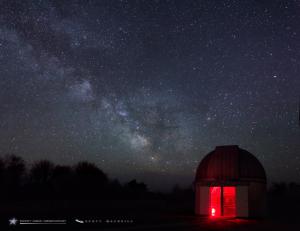
Public Stargazing
- Where:
- Frosty Drew Observatory
- When:
- Friday May 8, 2015 at 8:00 p.m.
- Cost:
- $1 Suggested Donation per Person
Tonight's forecast is calling for partly cloudy conditions becoming mostly cloudy overnight with dense fog moving in after midnight. The forecast is still variable at this point and could present us with acceptable viewing conditions, especially before 10:00 p.m. The 80% waning gibbous Moon will rise shortly after 11:00 p.m. and will bring with it a significant brightening of the sky. Though tonight, this could be our redeeming value. The super bright 80% Moon will be much easier to spot through thin cloud cover than most other celestial objects and could keep us open a bit longer once clouds move in.
We plan to open the Observatory and Sky Theatre at 8:00 p.m. tonight. In the Observatory, telescopes will feature Venus, which is in a beautiful 64% gibbous phase and shining like a beacon high in the Western sky after sunset. As dusk moves into twilight, Mercury will become visible just below Venus, on the Western horizon, and will be showing off a stunning 33% crescent phase. Jupiter will be brightly visible overhead sporting three of the four Galilean Moons and will be our next target if skies permit. Depending on the overall conditions of the sky, we could do some excellent galaxy spotting before the 11:16 p.m. moonrise. The Sky Theatre will be open with a slide show of astrophotos we shoot at Frosty Drew. If you haven't made it to the Sky Theatre yet, be sure to stop in and get lost in the presentation! We will stay open tonight until the clouds chase us out or the Moon gets too bright. Check in at @FrostyDrewOBSY on Twitter or the Frosty Drew Observatory Facebook before setting out. We will post updates and a “Closing up” status when we decide to start our break down operations.
Overall tonight could go either way. We could have excellent viewing or be completely clouded out. I would wager at this point that we see clear(er) skies after sunset until around 10:00 p.m. After which, clouds and fog will start to move in. Regardless, there will be no shorting of geekage and the Frosty Drew astronomers are all about getting it on with anybody willing to chat it up about astronomy.
-------------------------------------------------------------------------
Weekly Happenings
Scott MacNeill
After quite a period of near complete silence in sunspot activity on the solar photosphere. A new sunspot has emerged and it is crackling with solar flare awesomeness. After making an appearance earlier this week on the western limb of the Sun, sunspot AR2339 unleashed a massive X2 flare on Wednesday. The resulting CME from this huge flare was not Earth directed, though the sunspot continues to grow and has doubled in size as of mid-day Thursday. AR2339 is quickly moving into an Earth facing position and the likelihood of another large flare is quite probable. An Earth facing X-flare could release a CME directed at Earth bringing the fascinating Aurora Borealis to the polar regions of Earth and possibly as low as New England. Keep up with what is happening on the Sun with the NASA Solar Dynamics Observatory. Then keep an eye on the NOAA Ovation Aurora Forecast for a 30 minute heads up on geomagnetic activity (Aurora Borealis).
Over the past few nights and continuing over the weekend and this coming week, Mercury will be easily visible in the evening twilight sky just after sunset in the West. Though not nearly as bright as Venus, Mercury will appear much closer to the horizon and will show off a subtle yellow hue.
Being the closest planet to the Sun, Mercury has a rather quick orbital period when compared to Earth, with one year on Mercury lasting just under 88 days on Earth. Additionally, Mercury is near tidal locked with the Sun. A complete tidal lock, like the Moon, means that the same side of the orbiting object will always face the object it orbits. In this case, Mercury makes one full rotation on its axis over a period of two years on Mercury, or 176 Earth days.
Since Mercury is closer to the Sun than Earth, like Venus, we have to look towards the Sun to see it in our sky. With Mercury's fast orbit around the Sun, we periodically see Mercury low on the horizon just after sunset in the West or just before sunrise in the East. Though Mercury will never be visible high in the sky during the middle of the night, like Jupiter or Saturn. Another perk of Mercury's proximity to the Sun as it relates to Earth, is that we see Mercury in phases which are easily visible with a small backyard telescope. Unlike Venus, Mercury waxes and wanes much faster, taking only a couple of weeks to drop from a gibbous to a thin crescent.
Tonight will be the best night to view Mercury as it will be the highest off the Western horizon. Mercury will be showing off a stunning 33% crescent phase and will continue to wane over the weekend and next week. Make a point to get out there with binoculars, a telescope, or just a friend and catch a glimpse of the closest planet to the Sun, Mercury. If you happen to catch a photo of Mercury, be sure to post it on the Frosty Drew Observatory Facebook page and we will share it on our timeline.
-Scott


